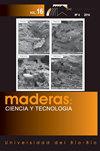Effect of the thermal treatment on the chemical components, sorption, and shrinkage properties of Tectona grandis juvenile wood
IF 1.5
4区 农林科学
Q3 MATERIALS SCIENCE, PAPER & WOOD
引用次数: 2
Abstract
The effect of thermal treatment on the chemical components, equilibrium moisture content (EMC), and shrinkage of teak juvenile wood was studied. Heartwood and sapwood samples were thermally-treated at 180 º C and 200 º C. Extractive, Klason lignin, holocellulose, and α -cellulose contents, as well as pH on untreated and thermally-treated woods, were determined. The EMC was reached at five relative humidity (RH) levels using saturated salt solutions: 86 % (KCl), 76 % (NaCl), 58 % (NaBr), 33 % (MgCl 2 ), and 0 % (P 2 O 5 ). Linear and volumetric shrinkages were calculated for all EMCs. The ratio of sorption (S), coefficient of shrinkage ( h ), and fiber saturation point (FSP) were also determined. Thermally-treated wood exhibited lower holocellulose and α -cellulose contents than untreated wood and increased acidity due to degradation of the hemicelluloses. The thermal treatment reduced the EMC of heartwood and sapwood. However, sapwood was more sensitive to RH variations than heartwood regardless of the treatment. Thermally-treated woods had higher hygroscopic and dimensional stabilities, and lower FSP than untreated wood. The thermal treatment did not affect radial shrinkage of the heartwood between 33 % and 86 % RH. Heartwood was more sensitive to the effect of the thermal treatment on shrinkage and degradation of cell wall polymers compared to sapwood.热处理对大构造木幼木化学成分、吸附和收缩性能的影响
研究了热处理对柚木幼木化学成分、平衡含水率和收缩率的影响。心材和边材样品分别在180℃和200℃下进行热处理,测定未处理和热处理木材的萃取物、木质素、纤维素和α -纤维素含量以及pH值。用饱和盐溶液在相对湿度(RH)为86% (KCl)、76% (NaCl)、58% (NaBr)、33% (MgCl 2)和0% (p2o 5)的条件下达到电磁兼容。计算了所有EMCs的线性和体积收缩。测定了吸附比(S)、收缩系数(h)和纤维饱和点(FSP)。热处理木材的纤维素和α -纤维素含量低于未经处理的木材,由于半纤维素的降解,木材的酸度增加。热处理降低了心材和边材的电磁兼容系数。但无论处理方式如何,边材对RH变化的敏感性均高于心材。热处理木材具有较高的吸湿性和尺寸稳定性,FSP低于未经处理的木材。在相对湿度为33% ~ 86%之间,热处理对心材的径向收缩率没有影响。与边材相比,心材对热处理对细胞壁聚合物收缩和降解的影响更为敏感。
本文章由计算机程序翻译,如有差异,请以英文原文为准。
求助全文
约1分钟内获得全文
求助全文
来源期刊

Maderas-ciencia Y Tecnologia
工程技术-材料科学:纸与木材
CiteScore
2.60
自引率
13.30%
发文量
33
审稿时长
>12 weeks
期刊介绍:
Maderas-Cienc Tecnol publishes inedits and original research articles in Spanish and English. The contributions for their publication should be unpublished and the journal is reserved all the rights of reproduction of the content of the same ones. All the articles are subjected to evaluation to the Publishing Committee or external consultants. At least two reviewers under double blind system. Previous acceptance of the Publishing Committee, summaries of thesis of Magíster and Doctorate are also published, technical opinions, revision of books and reports of congresses, related with the Science and the Technology of the Wood. The journal have not articles processing and submission charges.
 求助内容:
求助内容: 应助结果提醒方式:
应助结果提醒方式:


